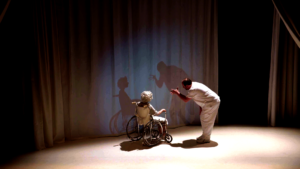To complement videos around Victoria by Dulcinea Langfelder, the company offers four short texts on themes that deepen our understanding of the piece.
Article
Victoria, shadows
MEANING
When we lose our memory, we can also lose the sense of the “self”; we do not recognize ourselves in the mirror. Thus, the reason why mirrors are rare in places where people who lose their cognitive faculties reside, because they can cause discomfort in people who perceive their reflection for that of a stranger.
By treating this phenomenon with shadows, the show addresses their symbolic dimensions. In some dialects in South America, the same word means shadow and soul. In some Asian philosophies, it is said that if one’s shadow separates from oneself, it means that one is dead. At noon, when the sun is directly at the top makes its shadow invisible, it is a moment of great serenity.
For his part, Carl Jung talked a lot about the shadow and said that as you get older, you can become more aware of the dark side of yourself. Jung encouraged confrontation with the shadow and acceptance of this hidden side that we drag with us. He said it was important to “digest your shadow”… that’s why Victoria eats it, outright!

FUN FACT
During the creation of Victoria, Dulcinea would often write in a café. One day, she was working on the scene where Victoria confronts her shadow. She imagined her character turning to her shadow and saying, “Look at me when I talk to you!” Dulcinea then turns to the wall next to her to check the exchange and, to her surprise, her shadow has turned TOWARDS her. Indeed, a shadow has only two dimensions; we cannot distinguish whether the shadow turns towards us or in the opposite direction. Just then, one of her friends – a tough and somewhat condescending guy – sees her and says, “Hey, Dulcinea, are you talking to your shadow? It’s not another person, it’s just you… I mean, that’s where the light hits you… where you block the light… well, it’s very simple! There’s nothing mysterious, it’s just a shadow!” It was a bit embarrassing… but very funny.

KEY MOMENTS
THE SISTER AND THE GRANDMOTHER
At the beginning of the play, we see that Victoria speaks in her shadow, taking it for her sister. In this scene, it’s about the real shadows. But later, when she remembers her grandmother, the shadow doesn’t do the same thing as Victoria (spoiler: it’s a video!). Here begins the shadow that guides and accompanies our heroine towards the end of her life.

THE BATH SCENE
The bath scene is inspired by a moment described by a real orderly who realizes, for a split second, that the person he is touching intimately is not just a patient, it is a woman. Through the play of shadows, we magnify this for a fraction of a second and we plunge into this inevitable intimacy in the relationship between caregiver and patient.

THE SUBTLE BODY
In the scene called the “subtle body”, the shadow becomes Kali, the Hindu goddess of birth and death. Victoria, tied up and trapped in her armchair, sees her subtle body, the macrocosm and the inevitability of her destiny.

 Created in 1999 for the stage, the work is transposed into a film in 2022. During 20 years of international touring, thousands of testimonials from all over have confirmed this; Victoria touches the viewer right in the heart and brings them a new capacity for tolerance.
Created in 1999 for the stage, the work is transposed into a film in 2022. During 20 years of international touring, thousands of testimonials from all over have confirmed this; Victoria touches the viewer right in the heart and brings them a new capacity for tolerance.
Synopsis
Victoria, 90, has lost her memory. In her world, time does not exist; memories are as real as the present. A shadow of herself, Victoria is like a stage performer who’s forgotten her role; a kind of puppet, adapting herself to comic, dramatic and poetic situations as they present themselves. The orderly that takes care of her seems at times to be a friend, an adversary, her father, son, brother, lover… while her wheelchair becomes her rocking chair, her prison, her tango partner and even a flying chariot that takes away her last breath.





